Naoko Hamada, Shuji Araki – Cultural Utilization Promotion for ISS in Japan – 2004
First publication workshop Space: Science, Technology and the Arts in collaboration with ESA/ESTEC, 2004
1. Introduction
Space utilization has been focused on communication services, Earth and astronomical observation using satellites, and science research such as the material / life science program on the Space Shuttle.
However, new activities other than the established research and development fields are now starting on the International Space Station (ISS) as humanity extends itself into space by constructing a permanent manned base.
ISS is the information dispatch base from space and the site of experimental sociology. ISS is expected to popularize the space utilization programs such as cultural, educational infrastructure and to solve global problems such as related to the social infrastructure. The following three points are innovative ISS ideas.
• To foster a global consciousness of diversity.
• To create a new viewpoint that produces human harmony and to urge a birth of a new cultures.
• To integrate science and technology with the humanities and social sciences.
This paper is a joint research effort from several universities. It seeks to clarify the possibility of humanities and sociology utilization on the ISS Japanese Experiment Module (JEM) and to clarify the problems with this approach.
2. Outline of activity
2.1 Activity introduction
In 1996, the Space Activities Commission (SAC)* recommended the promotion of culture and the humanities/social sciences through space environmental utilization. As a result of this recommendation, NASDA obtained a research contract with the International Institute for Advanced Studies in 1996 and 1997. From 1998 to 2000, this research contract defined the meaning and problems of ISS utilization from the viewpoint of humanities and social science with the help from specialists in the field. Subsequently, study groups comprised of specialists from various fields focused on the theme of the problems in the art, sociology and education fields and examined a practical activity plan.
*SAC is the Space Advisory Committee of the Ministry of Education, Culture, Sports, Science and Technology
2.2 Activities
After preliminary experiments on STS-87 in 1997 by a Japanese astronaut (Mr. Doi), the team was comprised of artists from several fields of study. They then initiated activities in the art field. In addition to those experiments and activities, the preliminary ground research initiated three years prior aimed to investigate the possibility of cultural utilization on the ISS with the Art University.
The KIBO*-Utilization Promotion Office was established in order to expand new fields of ISS and Japanese Experiment Module (JEM) utilization. This office promotes utilization in various fields (education, culture, art, and business). It advertised for themes and has so far executed three themes in cultural fields.
*KIBO is the Japanese name of the Japanese Experiment Module to be attached to the ISS.
KIBO means hope in Japanese.

2.3 Outline of activity
The main activity fields are (1) art and (2) dance.
(1) Art
(a) Future of Artistic Expression in a Microgravity Environment/Tokyo National University of Fine Arts and Music
This joint research seeks to investigate the possibility of artistic utilization on the ISS/JEM and to promote a new awareness of nature, humanity, and the world through research results and artwork.
(i) Space « MA » project: Residence space design
Human beings have lived and developed their histories in the gravitational context of Earth. Several features of the residence in ISS are: isolation, a microgravity environment, and a multi-cultural crew. This project made a comparative study of the sense of space on Earth and in the universe with regard to the special Japanese sense of “MA,”* primarily from the aspect of residence. Finally, they designed many images related to living space and furniture, similar to a traditional Japanese tea room.
*”””MA: This means space and interval in Japanese
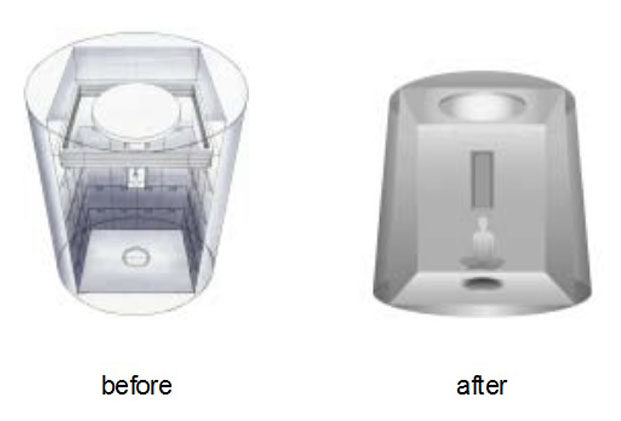
(ii) Venus project: Changes to the human-body’s beauty through microgravity
Currently, humans are conceived, produced and evolved in a gravity environment. Now, with human beings in a microgravity environment, the human body can be expected to change. This project researched the changing of the human-body and sense of beauty from the viewpoint of the artistic anatomy and form. The artists received detailed data of the head and face by parabolic flight and ground experiments. Finally, they created sculptures based on these data.
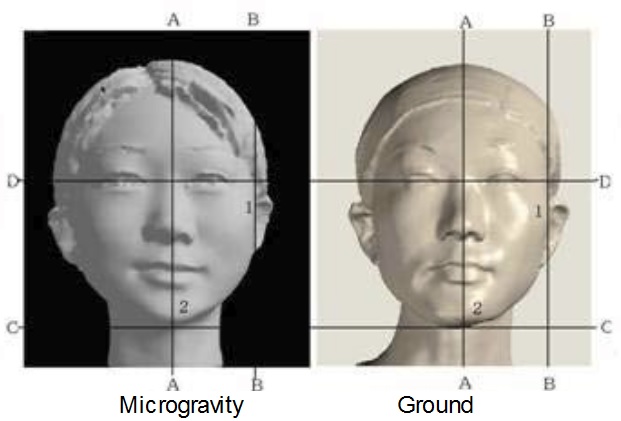
(iii) The Borderless Art Project: Art events and work production that connect the ground with the universe
In the past, only God could have a bird’s eye view of the Earth from space. However, human beings have now acquired the ability to view the Earth and universe from space. How should we reconsider the meaning of the Earth’s creation in the context of what we have thus far believed? The arts have been expressed, produced and enjoyed within the framework of religion, race, culture, and history, all of which occurred in terrestrial confines. In contrast, this project studied the possibilities of artistic expression that exceeds the frame of the ground, from the perspective of space. They then proposed an art event that held with space (STS, ISS) and earth at the same time.
(iv) History of human perception of the universe
The human perception of the world, nature and religion is connected with the universe. This perception gave rise to the belief that space led to another world, such as a life and death, God and humanity, the future and the past. By examining data related to such a universe, or of phenomena that reminds us of the universe, this project researched how we have expressed the universe in the context of the history of art and its traditional phases.
(b) Artistic Approach to Space /Kyoto City University of Arts
This research was launched in order to encourage research projects that embody new artistic concepts, conditions, potentials, and methods for artistic expression in space. This project also made specific proposals to create new relationships for humankind, the Earth and space by utilizing the ISS.
(i) KOKORO Project: An artistic experiment performed in a microgravity environment
This project has the following three objectives.
-To seek a new form of intellectual and sensible communication in the space environment, and provide global messages that originate in Japanese culture.
-To seek identifiable artistic expressions unique to the microgravity environment.
-To promote people’s instinctive understanding of space by identifiably presenting the microgravity environment.
They created the following artworks.
-Mind Garden: This artwork is a capsule-type human-sized apparatus for exploring changes in the senses and emotions that occur in space.
-Space Garden: This artwork, a garden suitable for the ISS environment, is made of moss.
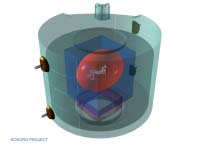
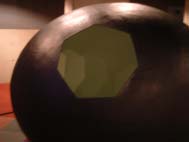
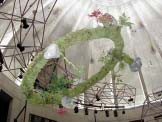
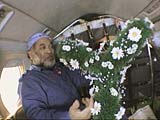
(ii) « COSMOS Project »: Fundamental research and data base construction
This project uses JAXA sources to investigate and analyze an astronaut’s experiences and information sources. It inspires other artistic expressions and is helpful for research projects. The results of the above-mentioned experiment are made widely available to the public as a database on the Internet, and many people have accessed it and participated.
(iii) WHERE PROJECT: Experiments on artistic communication between space and the Earth
The theme of this project is 1) the two “Here”s (ISS and the ground) and 2) “Where are we?,” the question of the position of humankind in the vast universe. This experimental art program connects space and the ground, and explores the ideal way of presenting this project to the public. They then reported the results to the public at the University.
(c) Presenting the process of human evolution right before us : Musasahino Art Unversity
In implementing this project, they deepened their understanding of outer space through interviews with Japanese astronauts who have first-hand experience living in space. The base theme is to present space art most effectively to people on the ground and pursue two themes for art.
(i) Works of art that heal the heart of space dwellers, are participation oriented, and provide joy in the process of creation.-“Sculpture released from the bonds of gravity.”
(ii) Posing the philosophical question of how we should continue to live from a perspective outside the Earth. “Communication of space and Earth”
They experienced artworks in parabolic flights.

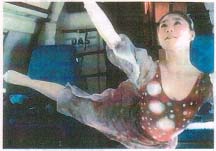
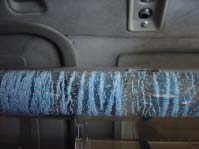
(2) Dance field
(a) The Flying Deities Project: Ochanomizu University
As we enter an age where activities in space take place constantly, it becomes increasingly important to examine human behavior in zero gravity environments from the viewpoint of arts and culture.
This project performed dances in zero gravity environments, and made a comparison between the actual performance and what people in ancient times imaged it to be like dancing in such an environment.
People in many cultures have imagined celestial beings flying, but this project focused on the East Asian tradition, or more specifically, the murals of the flying deities (Hiten in Japanese) in Dunhuang, China and Asuka, Japan.
The performance was examined twice by parabolic flight. Two attempts at reenacting a dance of the flying deities in zero gravity demonstrate the possibility of realizing the ancient people’s adoration of the celestial world, and also give us an important clue in studying effective movement in zero gravity.
(b) Study of new posture with the dance group ‘Tokyo Space Dance’
Space dance is the name of the new Butoh dance, a collaborative art with science, architecture, information and design. Initially, the dance group ‘Tokyo Space Dance’ (TSD) tried to create a new human posture, noting that the posture is related to the conditions of space. TSD believes human beings who live in space will have new postures in zero gravity environments.
In addition, TSD wants to study new lifestyles in the era of living in space or on the Moon, bearing in mind that life style significantly relates to human posture.
JAXA looks forward to hearing such proposals from TSC because it is difficult for engineering staff or scientists to have as imaginative ideas as the collaborative artists.
3. View of the future
The fields of the humanities/social science and cultural utilization using ISS have the potential to contribute to the ISS program. However, it will be necessary to continuously advance practical objectives and promote effective strategies in the future because this field is a wide, rudimentary activity that has just started.
JAXA will aim (a) to develop human beings who have full consciousness of living on the Earth, (b) develop a futuristic human race, (c) create a new value in space utilization through cultural activities. The following will facilitate this development.
(1) Community cultivation
• Reporting research results to the public generates new researcher participation and extends utilization. We need to offer information to the general public and to elicit new participation.
• Parabolic flight experiments are effective for research of the humanities in a microgravity environment. Therefore, it is necessary to establish research support systems for ground research and preliminary experiments by parabolic flight.
(2) Construction of a utilization system for JEM
• All tangible experiments of humanities/sociology do not necessarily have to be conducted in JEM, just like in science and technology research. However, there are many utilization requests for JEM. In practical terms, we would like to experience artwork in JEM and to use images in ISS/JEM. To this end, we must establish a systematic way to accept proposals from the cultural and humanities fields, because this is not defined in the current JEM utilization system.
(3) Strengthening of support system
• A technical adjustment is needed in the humanities/sociology and cultural utilization. A special system must be established to technically support the user.
References
[1] S. Ishiguro, “The Flying Deities Project: an Attempt at performing East Asia Ancient Dances in Zero Gravity Environments ”, Science & Technology In Japan, Vol.22, p27,28,2003.
[2] Y.Yonebayashi, T. Ito, R.Miyata, K.Katayama, H.Sakaguchi, S.Onobori, D.Sato, H.Honogou, S.Kitagou, R.Taho, H.Furukawa, M.Satsuma, M.Miyanaga, “Social Science in a Micro-gravity Environment”, Science & Technology In Japan, Vol.22, p29-31,2003.
[3] N.Fukushima, H.Nomura, T.Ikegami, T.Fujiwara, A.Inoue, K.Nakahara, S.Matsui, M.Towata, “Artistic Aproach to Space”, Science & Technology In Japan, Vol.22, p32-34,2003.
[4] T.Ousaka, “Pressing the Process of Human Evolution Right Before Us”, Science & Technology In Japan, Vol.22, p27,28,2003.
[5] Tokyo National University of Fine Arts and Music, National Space Development Agency of Japan,”Future of Artistic Expressions under Microgravity Environment”, NASDA Technical Memorandum, August 2003.
[6] Space utilization Research Proguram/Center ”Activity Report”, NASDA Special Publication, September 2003.
© Naoko HAMADA, Shuji ARAKI & Leonardo/Olats, mai 2004, republished 2023
Leonardo/Olats
Observatoire Leonardo des Arts et des Techno-Sciences
À propos / About | Lettre d'information Olats News



Pour toute (re)publication, merci de contacter / For any (re)publication, please contact Annick Bureaud: info@olats.org
Pour toute question concernant le site, merci de contacter / For any issue about the website, please contact: webmaster@olats.org
Design Thierry Fournier
© Association Leonardo 1997-2022